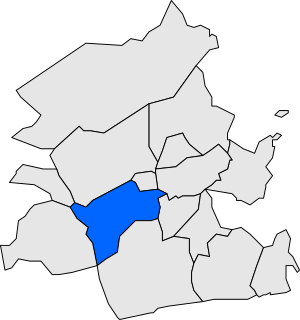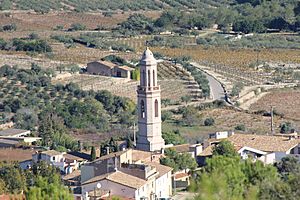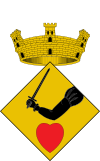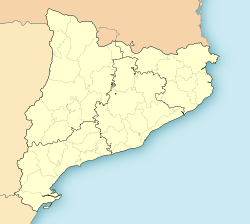Albinyana facts for kids
Quick facts for kids
Albinyana
|
||
|---|---|---|
|
municipality
|
||

Albinyana, at the foothills of the Coast Rovira, seen from a vineyard
|
||
|
||
| Nickname(s):
Albiñana
|
||

Location of Albinyana in Baix Penedès
|
||
| Country | ||
| Autonomous Communities of Spain | ||
| Province | ||
| Region | Baix Penedès | |
| Area | ||
| • Total | 19.4 km2 (7.5 sq mi) | |
| Population
(2018)
|
||
| • Total | 2,371 | |
| • Density | 122.2/km2 (316.5/sq mi) | |
| Postal code |
43718
|
|
Albinyana is a small village in Spain. It's located in the Catalonia region, specifically in the province of Tarragona. This village is part of the Baix Penedès area. In 2009, about 2,275 people lived there.
Contents
A Look at Albinyana's Past
In the 11th century, a nobleman named Viscount Guitard built a castle in Albinyana. His son, Adalbert, later gave the castle to the Monastery of San Cugat. Adalbert died during the Reconquista, which was a long period when Christian kingdoms in Spain fought to take back land from Muslim rule.
In 1040, the monastery's leader gave the land to Bernat Otger. He had to rebuild the castle and protect it. The castle was near the border, so people worried about attacks. Because of this, the castle was empty for a long time. It stayed with the monks of Sant Cugat until the system of lordships ended. Today, no parts of the castle remain. People believe it stood where the village center is now.
There were also two other old forts nearby. One was the Esquena Roja castle, mentioned in papers from 1173. It later became a farmhouse. The other was Tomoví castle. Documents suggest it was more like a strong, fortified house than a true castle.
Exploring Albinyana's Old Buildings

The main church in Albinyana is dedicated to St. Bartholomew. Records show it belonged to San Cugat in 1120. However, the church building you see today was built in the 18th century. It has a round end part called a semicircular apse. Its bell tower is square and has a small angel statue on top.
In the main square, Plaza Major, stands another important building called Cal Pau Magí. This building is from the 17th century and has three floors. Inside, there's a special entrance hall with an arched ceiling. The date 1637, when it was built, is carved into the stairs. This building used to be where the San Cugat administrator lived.
In an area called Les Peces, you'll find a large building known as Cal Gener. This building dates back to the 15th and 16th centuries, but it was rebuilt in the 18th century. Its windows are framed with stone. The outside walls have interesting designs called sgraffiti, which were fixed in 1984. These designs show human figures and different shapes. Today, Cal Gener is a house-museum where visitors can learn about rural life and stay for tourism.
The Sant Antoni hermitage is a small church located just outside Albinyana. It was built in the 18th century. It has a rectangular shape and a sloped roof. Inside, the ceiling is a barrel vault, which is a rounded arch shape. Outside, there are strong supports called buttresses. A tower is attached to it, used as a bell tower. People think this hermitage was once part of the old castle's defenses. It sits on a small hill and is completely white.
How Albinyana Makes a Living
The main way people in Albinyana earn money is through farming. They grow crops that rely on rainfall, like grapes for vineyards, grains, almonds, and hazelnuts. Before the mid-20th century, there was also a big industry here that made baskets from palm leaves.
Fun Local Celebrations
The village of Albinyana has two main festivals each year. One celebration takes place in July, around the time of the Virgen del Carmen holiday. The other big festival is on August 24th, which is the feast day of San Bartolomé.
Photo gallery
See also
 In Spanish: Albiñana para niños
In Spanish: Albiñana para niños





